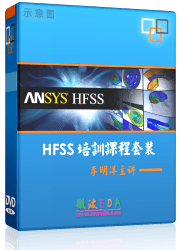|
 Ansoft Designer / Ansys Designer 在线帮助文档: Ansoft Designer / Ansys Designer 在线帮助文档:
Terms in Designer >
Glossary: S
Glossary: S
Sample rate
Time increment of analysis. Sometimes referred to
as sampling rate.
Sampling
The process of converting an analog signal into a
series of digital values.
Scalar Notation
A notation in which each signal is assigned a unique
name; for example, a3, a2, a1, and a0.
Scaling
A technique for making transistors switch faster by
reducing their size. This strategy is known as scaling, because all
of the transistors features are typically reduced by the same proportion.
Schematic
Common name for a circuit diagram.
Scrubbing
The process of vibrating two pieces of metal, or metal
coated materials, at ultrasonic frequencies to create a friction weld.
Seed Value
An initial value loaded into a linear feedback shift
register or random number generator.
Sensor
A transducer that detects a physical quantity and
converts it into a form suitable for processing. For example, a microphone
is a sensor which detects sound and converts it into a corresponding
voltage or current.
Sequential
A function whose output value depends not only on
its current input values, but also on previous input values. That is,
the output value depends on a sequence of input values.
Side-Emitting Laser Diode
A laser diode constricted at the edge of an integrated
circuit's substrate such that, when power is applied, the resulting
laser beam is emitted horizontally; that is, parallel to the surface
of the substrate.
Sign Bit
The most significant binary digit, or bit, of a signed
binary number. If set to a logic 1, this bit represents a negative quantity.
Signal Conditioning
Amplifying, filtering, or otherwise processing a signal.
Signal Layer
A layer carrying tracks in a circuit board, hybrid,
or multichip module. See also wiring layer.
Signature
Refers to the checksum value from a cyclic-redundancy-check
when used in the guided-probe form of functional test.
Signature Analysis
A guided-probe functional-test technique based on
signatures.
Signed Binary Number
A binary number in which the most-significant bit
is used to represent a negative quantity. Thus, a signed binary number
can be used to represent both positive and negative values.
Sign-Magnitude
Negative numbers in standard arithmetic are typically
represented in sign-magnitude form by prefixing the value with a minus
sign; for example, -27. For reasons of efficiency, computers rarely
employ the sign-magnitude form. Instead, they use signed binary numbers
to represent negative values.
Silicon Bumping
The process of depositing additional metallization
on a die's pads to raise them fractionally above the level of the Barrier
Layer.
Silicon Chip
Although a variety of semiconductor materials are
available, the most commonly used is silicon and integrated circuits
are popularly known as silicon chips, or simply chips.
Silicon Compiler
The program used in compiled cell technology to generate
the masks used to create components and interconnections. May also be
used to create data-path functions and memory functions.
Single-Sided
A printed circuit board with tracks on only one side.
Sintering
A process in which ultra-fine metal powders weld together
at temperatures much lower than those required for larger pieces of
the same materials.
SIPO (Serial-In Parallel-Out)
Refers to a shift register in which the data is loaded
in serially and read out in parallel.
SISO (Serial-In Serial-Out)
Refers to a shift register in which the data is both
loaded in and read out serially.
Skew
Time delay between different bits transmitted at the
same time, measured at the receiver.
Skin Effect
In the case of high frequency signals, electrons are
only conducted on the outer surface, or skin, of a conductor. This phenomenon
is known as the skin effect.
Small-Scale Integration (SSI)
Refers to the number of logic gates in a device. By
one convention, small-scale integration represents a device containing
1 to 12 gates.
SMD (Surface Mount Device)
A component whose packaging is designed for use with
surface mount technology.
SMOBC (Solder Mask Over Bare Copper)
A technique in which the solder mask is applied in
advance of the tin-lead plating. This results in lighter circuit boards
because the tin-lead alloy is only used to plate the pads.
SMT (Surface Mount Technology)
A technique for populating hybrids, multichip modules,
and circuit boards, in which packaged components are mounted directly
onto the surface of the substrate. A layer of solder paste is screen
printed onto the pads and the components are attached by pushing their
leads into the paste. When all of the components have been attached,
the solder paste is melted using either reflow soldering or vapor-phase
soldering.
SNR
Signal-to-noise ratio.
Soft Macro (Macro Function)
A logic function defined by the manufacturer of an
application-specific integrated circuit. The function is described in
terms of the simple functions provided in the cell library and connections
between them. The assignment of cells to basic cells and the routing
of the tracks is determined at the same time, and using the same tools,
as for the other cells specified by the designer.
Solder Bumping
A flipped chip technique in which spheres of solder
are formed on the die's pads. The die is flipped and the solder bumps
are brought into contact with corresponding pads on the substrate. When
all the chips have been mounted on the substrate, the solder bumps are
melted using reflow soldering or vapor-phase soldering.
Solder Mask
A layer applied to the surface of the substrate that
prevents solder from sticking to any metallization except where holes
are patterned into the mask.
Solder Mask Over Bare Copper (SMOBC)
A technique in which the solder mask is applied in
advance of the tin-lead plating. This results in lighter circuit boards
because the tin-lead alloy is only used to plate the pads.
Solution
A solution is the successful result of an analysis,
or imported results available for plotting.
Space
Used to refer to the width of the gap between adjacent
tracks.
SPICE
Simulated Program for Integrated Circuit Emulation
SRAM (Static RAM)
A memory device in which each cell is formed from
four or six transistors configured as a latch or a flip-flop. The term
static is used because, once a value has been loaded into an SRAM cell,
it will remain unchanged until it is explicitly altered or until power
is removed from the device.
SS-CDMA
Spread-spectrum code-division multiple access.
SSI (Small-Scale Integration)
Refers to the number of logic gates in a device. By
one convention, small-scale integration represents a device containing
1 to 12 gates.
Stackup
Signal layer, metallized signal layer, dielectric
layer, rats layer, and so on.
Standard Cell
An application-specific integrated circuit which,
unlike a gate array, does not use the concept of a basic cell and does
not have any pre-fabricated components. The manufacturer creates custom
masks for every stage of the device's fabrication allowing each logic
function to be created using the minimum number of transistors.
State Assignment
The process by which the states in a state machine
are assigned to the binary patterns that are to be stored in the state
variables.
State Diagram
A graphical representation of the operation of a state
machine.
State Machine
The actual implementation (in hardware or software)
of a function that can be considered to consist of a set of states through
which it sequences.
State Table
A tabular representation of the operation of a state
machine. Similar to a truth table, but also includes the current state
as an input and the next state as an output.
State Transition
An arc connecting two states in a state diagram.
State Variable
One of a set of registers whose values represent the
current state occupied by a state Static Flex
Statement
A sentence that asserts or denies an attribute about
an object or group of objects. For example, "Your face resembles a cabbage."
Static Flex
A type of flexible printed circuit which can be manipulated
into permanent three-dimensional shapes for applications such as calculators
and high-tech cameras which require efficient use of volume and not
just area.
Static RAM (SRAM)
A memory device in which each cell is formed from
four or six transistors configured as a latch or a flip-flop. The term
static is used because, once a value has been loaded into an SRAM cell,
it will remain unchanged until it is explicitly altered or until power
is removed from the device.
Steady State
A condition in which nothing is changing or happening.
Subatomic Erosion
A process in which structures on an integrated circuit's
substrate are eroded by the flow of electrons in much the same way as
land is eroded by a river (also known as electromigration)
Substrate
Generic name for the base layer of an integrated circuit,
hybrid, multichip module, or circuit board. Substrates may be formed
from a wide variety of materials, including semiconductors, ceramics,
FR4 (fiberglass), glass, sapphire, or diamond depending on the application.
Note that the term substrate has traditionally not been widely used
in the circuit board world, at least not by the people who manufacture
the boards. However, there is an increasing tendency to refer to a circuit
board as a substrate by the people who populate the boards. The main
reason for this is that circuit boards are often used as substrates
in hybrids and multichip modules, and there is a trend towards a standard
terminology across all forms of interconnection technology.
Subtractive Process
A process in which a substrate is first covered with
conducting material, then any unwanted material is subsequently removed,
or subtracted.
Superconductor
A material with zero resistance to the flow of electric
current.
Surface Mount Device (SMD)
A component whose packaging is designed for use with
surface mount technology.
Surface Mount Technology (SMT)
A technique for populating hybrids, multichip modules,
and circuit boards, in which packaged components are mounted directly
onto the surface of the substrate. A layer of solder paste is screen
printed onto the pads and the components are attached by pushing their
leads into the paste. When all of the components have been attached,
the solder paste is melted using either reflow soldering or vapor-phase
soldering.
Surface-Emitting Laser Diode
A laser diode constricted on an integrated circuit's
substrate such that, when power is applied, the resulting laser beam
is emitted directly away from the surface of the substrate.
Synchronous
(1)A signal whose data is not acknowledged or acted
upon until the next active edge of a clock signal. (2)A system whose
operation is synchronized by a clock signal.




HFSS视频教程
ADS视频教程
CST视频教程
Ansoft Designer 中文教程
|